Abstract
The contemporary speed at which opinions move on social media makes them an undeniable force in the field of opinion mining (OM). This may cause the OM challenge to become more social than technical. This is when the process can determinately represent everyone to the degree they are worth. Nevertheless, considering perspectivism can result in opinion dynamicity. Pondering the existence of opinion dynamicity and uncertainty can provide smart OM on social media. This study proposes a neutrosophic-based OM approach for Twitter that handles perspectivism, its consequences, and indeterminacy. For perspectivism, a social network analysis (SNA) was conducted using popular SNA tools (e.g., Graphistry). An influence weighting of users was performed using an artificial neural network (ANN) based on the SNA provided output and people’s reactions to the OM analyzed texts. The initiative adoption of neutrosophic logic (NL) to integrate users’ influence with their OM scores is to deal with both the opinion dynamicity and indeterminacy. Thus, it provides new uncertainty OM scores that can reflect everyone. The OM scores needed for integration were generated using TextBlob. The results show the ability of NL to improve the OM process and accurately consider the innumerable degrees. This will eventually aid in a better understanding of people’s opinions, helping OM in social media to become a real pillar of many applications, especially business marketing.
1. Introduction
Nowadays, the fact that social media is the main source of digital marketing and market research information (e.g., news and reviews) is solidified [1,2]. With billions of active users on different online social networks (OSNs), people have started to eliminate global barriers by sharing their thoughts, opinions, and feelings toward everything [3,4]. The core strength of these OSNs is their influence; companies can communicate with their customers with positive content to boost motivation towards their products or services. Interestingly, people rather than companies are proved to be the leading engine of influence on OSNs; they can drive public orientation towards anything in a matter of seconds [5]. In either case, opinion mining (OM) or sentiment analysis (SA) is essential to analyze opinions, for companies to obtain insight into how their marketing strategies performed, how people on OSNs talk about them, and then take corrective actions afterward to improve their business [6].
Opinions are expressed by humans (i.e., opinion holders about an entity or features of an entity at a given time) [6]; business owners, who aim at improving their market image, pay more attention to searching for opinion holders of good impact on OSNs to spread opinions of positive orientations about their business entities and their features [6,7]. Social network analysis (SNA) was applied to OSNs to highlight influencers for businesses to spread positive opinions of their business [7]. Using the graph and network theory, SNA is one way to study the importance of users in their social networks. The centrality measure in SNA is one primary assessment for detecting influential nodes (i.e., users) in a given graph network [4]. However, this sort of action can increase the diffusion of positive opinions with no effect on the main process; OM deals with opinion texts only [1].
The subjective nature of opinions makes them subject to many types of uncertainty when being automatically analyzed. For example, opinions have gradient polarity; two positive texts are not positive to the same degree. Moreover, undecided polarity can happen when text polarity is at an equal distance between two polarity classes. At that instant, the machine makes the approximate or dominant choice (e.g., neutral class). Likewise, many neutral classified opinions are undecided (e.g., having the same opposite polarity) but such a class is not considered in OM classification [8]. These innumerable degrees reflect reality and are found in social media texts, which then need to be considered for more accurate and real OM results. More than that, when individuals perform text rating, this may cause the generation of different rates for the same texts based on the observers’ perspective. Opinion dynamics on OSNs is one possible result of perspectivism, thus correlated with SNA in the determinacy of users’ importance and trust degree [7,9,10].
All the above-mentioned cases can be easily detected and solved by humans, but hardly processed by machines [4]. Leaving aside its unfamiliar implementation in OM, the nature of neutrosophic logic (NL) is highly integrated with how humans think, where an indefinite environment is a human’s ordinary space to draw a conclusion or make a judgment due to incomplete knowledge. Furthermore, NL is malleable in terms of accepting different values from observers. Thus, NL can acquire some mental ability for the OM process to become smart. In NL, each object in a certain universe has a degree of truth , a degree of indeterminacy (), and a degree of falsity , where are standard or non-standard real subsets of . Such a classification might help in determining the percent of indeterminacy in a text’s polarity [9].
The main objectives of this study are to reduce social bias through algorithmically certain and more accurate OM classification results befitting trust. The proposed model can improve the process of OM in OSNs by highlighting the most irritating technical problems that are caused by the social tendency of the application domain.
The remainder of this paper is planned in the following way. In Section 2, social media-based research is classified and briefly discussed in a literature-based approach. Section 3 highlights the research problem for Section 4 to define how the proposed model is intended to solve it. The required validations and their resulting analysis are presented and elucidated in Section 5. Conclusions are drawn in Section 6.
2. Related Work
Research that is based on analyzing social media data are gaining massive attention [4,6]. In the literature, this research type is performed to serve many applications (e.g., market, health care, etc.), and they are mostly classified into structural-based and content-based analyses [4]. The structural-based analysis deals with the main social network structure, studies nodes (i.e., users) interactions, and the network topology. The content-based analysis deals with content being created by nodes and shared on social media [4]. Figure 1 shows the classification of social media data-based research.
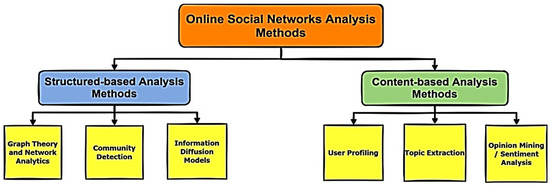
Figure 1.
Social media data-based research classification in the literature.
In marketing applications, business owners and researchers are concerned about the structural-based analyses that include SNA to find influencers [10]. In line with that, in 2017, most research found OSNs’ influencers based on graph theory by measuring network topology (e.g., degree of centrality, betweenness, etc.) [4,11]. Jianqiang et al. [12] proposed measuring influence based on considering not only the structural-based analysis of social media data (i.e., graph theory), but also the influence of users’ tweets by considering retweets, replies, and favorite counts. They believed that the content of tweets itself can influence people as much as their authors. They tested their proposed model, and it was found to be a better method than the compared methods. In 2020, concerning the community detection under the same analysis type, Oueslati et al. [7] highlighted the problem of detecting opinion leaders on dynamic social graphs. They attempted to consider the dynamic nature of online social networks (OSNs) while detecting opinion leaders on social media. They proposed a new model that collected Facebook posts and then filtered them based on the included opinion words and the text type (i.e., status). They considered posts important when having higher opinion words and social reactions. Accordingly, influencers were the ones whose posts had the highest combined score. Experiments on real data collected from Facebook were performed. The validation of the model was compared with some previous work, and the results showed good performance of this model when considering the dynamic nature of the network.
It was found that the isolated application of one analysis, whether it was structural or content-based, can cause information incompleteness, essential patterns, and knowledge loss [4]. This caused a few researchers to combine both analyses for different application purposes. In 2021, Jin et al. [13] attempted to combine both the content-based analysis (i.e., SA) with the structural-based analysis (i.e., SNA) by designing a new sentiment link analysis using a graph network to predict users’ attitudes towards an entity. They considered the problem of determining users’ attitudes towards entities without the normal analysis of text sentiment. They tried to solve the problem of the undecided polarity of tweets posted by their authors on social media due to the short text or unclear wording to retrieve users’ real attitudes. They also tried to predict the hidden attitude when users did not share their opinions on social media. They modeled the information network to retrieve unknown sentiment links based on users’ social relationships, user attributes, and movie attributes. Experiments were conducted using movies reviewed from Weibo gaming proving the effectiveness of this method on some state-of-art methods.
In the same year, Chauhan et al. [14] highlighted the importance of predicting election results based on three approaches by surveying 38 papers on election prediction. The three approaches were: the volumetric approach (counts of posts, likes, etc.); the content-based analysis in the form of the SA approach (polarity of posts); and the structural-based analysis in the form of SNA (measure centrality of supporters). They found that most research depended on SA, either alone or combined with a volumetric approach. Only one paper combined the three approaches. They concluded the need for more efforts in this field to produce a more valid and acceptable model for election result prediction (e.g., to detect spam accounts, sarcasm, etc.).
Regarding the implementation of the NL technique in the literature, it was found to be applied in many fields (e.g., image processing and disease diagnosis) with no real application to SA not long ago [8]. Some researchers have investigated the significance of NL by conducting theoretical comparisons with other existing logics (e.g., intuitionistic logic and fuzzy logic) [15,16,17].
Due to the low implementation rate of NL, there are a lack of findings for a specific software tool for NL. Consequently, a few researchers have started to suggest an implementation method for applying NL in practice [9]. In 2012, Ansaria et al. [9] mentioned the problem of not having any available software for NL. They presented full-detailed steps for generating an NL classifier based on the fuzzy toolbox of MATLAB. It followed the same idea of constructing three fuzzy inference systems (FIS) representing each component of NL. They also illustrated the ambiguity cases in detail for the Iris dataset when applying fuzzy and NL systems, showing how professionally NL can deal with ambiguity cases. In the same direction, in 2016, Basha et al. [18] suggested the utilization of a knowledge-based rule-based system due to the close resemblance between human thinking and rule-based approaches. They proposed a neutrosophic rule-based system to handle uncertainty, in particular, ambiguity due to the overlap areas in classification. The proposed model designates rules and non-overlap membership functions for each NL output component. Rules were trained and tested on three datasets (e.g., the Iris dataset). A comparison with a fuzzy system was conducted to prove the ability of the NL system to handle ambiguity with better accuracy.
In 2018, Bhutani et al. [19] highlighted the importance of rule-based classification using fuzzy logic for its ability to handle interpretation and its weakness in handling uncertainty. The authors in [19] followed the same concept and steps as in [18]. They constructed an NL classifier on the same line as their fuzzy classifier. The difference was in designing the membership functions. In NL, the output must be represented in triple format components. For each component, they designed non-overlapping membership functions for both input and output and the component rules. The constructed NL classification model was practiced on an appendicitis dataset and then compared with the ordinary fuzzy classifier as a performance test. The comparison demonstrated the superiority of the NL classifier in handling ambiguity in the data classification.
In dealing with the uncertainty and OM, in 2017, Smarandache et al. [20] attempted to express the importance of the NL in dealing with uncertainties and how it can handle idea dynamicity. They applied NL in an election process where blind and null votes might represent a high percentage and needed to be processed. They proposed a refining process based on minimizing the rate of indeterminacy and increasing the truth and falsity rates in returns, thus minimizing uncertainties. Using NL, they succeeded in finding and effectively refining these types of votes. In 2019, Smarandache et al. [21] addressed the problem of word similarity. They attempted to design a new word similarity measure based on sentiment results obtained from SentiWordNet 3.0. This considered the challenge of multi-meaning words by measuring the semantic distance from a seed word using a neutrosophic approach. They proposed an NL method for classifying the sentiment of words by measuring distances to seed words representing each standard polarity class. They applied Hamming distance, Euclidean distance, and Intuitionistic Euclidean distance to evaluate the accuracy of the method where promising results were obtained.
In 2020, Kandasamya et al. [8] suggested a refined process for SA polarity results from TextBlob to handle the problem of indeterminacy in polarity. They proposed a multi-refined neutrosophic set where polarity scores resulted are refined into seven polarity classes (i.e., strong positive, positive, indeterminate positive, indeterminate, indeterminate negative, negative, and strong negative). Another two methods were applied, where polarity scores were classified into five and three classes, respectively. A comparative study was conducted between their model and the two other used methods. Tests were performed on 10 different datasets to see how well the three methods worked at evaluating them. The results showed that the proposed refined method was the best.
In conjunction with the continuous production of social media-based research, this work combined both structure and content-based methods by utilizing a neutrosophic-based OM approach that can provide each author with a polarity score for his text that depends on his influence level. A new element to the basic five opinion elements that represented the influence level was added. This model applies a novel classification of the opinion holders into four types based on their centrality measures and the reactions to their texts using an artificial neural network (ANN). SNA was performed using several software tools that are available online to provide the required information about authors’ topologies in their OSNs. People’s opinions and text polarity scores are combined for the first time in this model. It also takes into account text indeterminacy and dynamicity with NL.
3. Problem Definition
On OSNs, each of the basic opinion elements (,,,) spearheads the orientation of opinions () to which they belong. At a given time (), billions of opinion holders () share their opinions at tremendous speed about any entity () or/and its features (); OM must automatically deal with the frequent increase in opinions and their orientation () change over time [22]. One reason for the orientation change is the influence; people on OSN can establish credibility in areas of wide audience interest due to their personality, knowledge, or simply for sharing relatable content. They can have different observations of the same entity, leaving the decision to the audience to agree with whom they trust more. Nevertheless, OM treats opinions as pure text with the same importance, whether they are expressed by a professional, expert, influencer, spammer, or ordinary person. Contrary to the norm, opinion holders in the eye of OM are equally likely threaten the credibility of opinions and the validity of results. Back to the content being processed, OM can process features of an entity when more detailed opinions are important, and only the entity when detailed opinions are less important. However, writing opinions on OSNs in a spoken language increases the risk of content uncertainty as well as the hardiness of determining its main scope.
These issues doubt the ability of OM on OSNs in reflecting reality providing low-quality information-based results for OM beneficiaries and decision makers. Accordingly, improving the process of OM on OSNs became an insistence. In the achievement of such, the OM process should take into consideration the influence of users and their perspective power as well as the uncertainty of texts and their impact on result efficiency. A summary of the problems to be solved in this study is as follows:
- -
- The compulsory dependency on low-quality information for the OM process and its reflection on providing invalid results for decision making;
- -
- The scarcity of parallel processing of perspectivism (i.e., users’ credibility) with the main OM process;
- -
- The need for effective ways to determine and numerically represent users’ credibility;
- -
- The inefficient consideration of opinion dynamics in generating a sensitive consensus opinion;
- -
- The continuous need for decreasing ambiguity in opinion texts;
- -
- The absence of a methodical integration between polarity scores and text perspectivism in the process of OM to provide a polarity score that reflects real intentions.
4. Proposed Model
The above-mentioned problems caution the ability of OM, in its current state, to be applied to OSNs. The main shortage is in the sedulity to use the same opinion elements while being applied to OSNs and their environmental uncertainty. The proposed model aims to improve the effectiveness of applying OM to Twitter. To solve the mentioned problems, we should readapt the opinion elements to accommodate the application domain properties. Accordingly, we need to introduce new elements to qualify the OM process on OSNs that are specifically related to opinion holders’ hallmarks and social reactions to their actions. Other than that, we must solve common uncertainty problems that can improve the opinion classification process. The proposed model mainly focuses on all the previously mentioned problems while holding the following contributions:
- -
- The proposed model suggests adding a new element (assume: ) to the five elements of opinion, describing the importance of opinion holders and their reactions to their opinions. This element takes into consideration the impact of the opinion holder and his reaction to his opinion on the assigned opinion orientation. Importance weighting should be applied to opinion holders so that they are provided weights based on their authority over the audience. As such, perspectivism can be practically represented in the main OM process;
- -
- The users’ weighting method is proposed in this model, which depends on applying SNA and ANN. A comparative analysis of three famous SNA tools must be conducted to adopt the most applicable one. ANN is applied to rank users based on their centrality measure produced by the SNA tool as well as the reaction-based features of users’ texts (i.e., likes, shares, etc.). Weights are provided based on users’ ranks; the top-ranked is the most weighted and vice versa. ANN was chosen for being efficient in dealing with the complicated behavior of humans that could not be mathematically represented;
- -
- The innovative adoption of NL is to integrate the new elements with the other traditional elements of opinion. Moreover, NL adoption hybrids the process of OM, providing more accurate polarity scores through performing the OM combining lexicon with machine learning (ML) (i.e., TextBlob and NL). Finally, NL was proven to effectively deal with uncertainty especially opinion ambiguity and dynamicity. Figure 2 presents the proposed model and its components. The phases of the proposed model are described as follows:
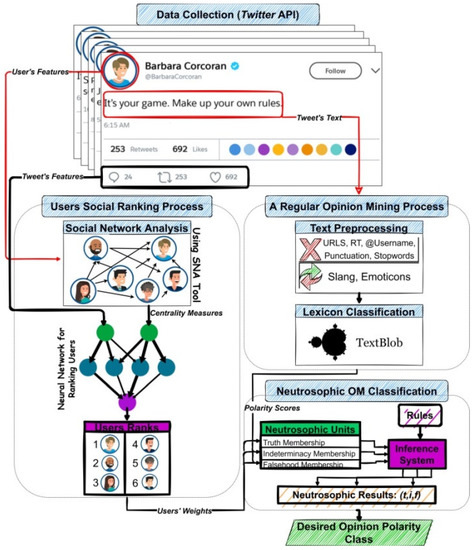 Figure 2. The proposed NL-based OM model.
Figure 2. The proposed NL-based OM model.
4.1. Data Collection Phase
Any model requires data to work on and test its validity. For OM, this phase is essential to identify most of the opinion elements (i.e., , , , and ). In this proposed model, Twitter is the chosen OSN, and thus, the Twitter API was used to collect the necessary data. For the proposed model and adding to the traditional data required in any OM process, data about opinion holders and their tweets’ reaction-based features are to be essentially required for collection. The previously collected data in [10] were used for this work due to the lack of availability of data that include both aspects of opinion holders, and their tweets’ features, along with the main opinion texts. Accordingly, for this model, the data required to represent opinion elements were as follows:
- -
- Opinion text in the English language, per user;
- -
- , the opinion entity is the World Football Cup 2018 and all its possible aspects (e.g., video assistant referee (VAR));
- -
- indicates username of the opinion holder;
- -
- opinions that were collected during the period from 14 June 2018 till 15 July 2018, and;
- -
- The contribution support data that include: follower/following list of and the likes, retweets, and replies counts for their collected opinion tweet.
4.2. Users Weighting Process
This contribution phase is divided into two main steps: SNA then ANN ranking and weighting processes. Data collected from the first phase about the newly added elements is mainly required to execute this phase. Follower/following lists and tweets’ features are individually used as follows:
- (1)
- Social Network Analysis (SNA)
This step works with follower/following lists of opinion holders. Using SNA, users in a given social network can be provided some centrality measures representing their importance in this network. Owning higher centrality measures indicates more central, influential, and powerful users [4,23]. The most considered centrality measures in this work are degree, betweenness, and closeness centrality. They measure the popularity of nodes through counting connections, how users control information diffusion in the network, and how quickly information spreads from users, respectively [23]. By applying some available SNA tools and using the collected follower/following lists, a graph of users can be constructed. In such a graph, a user is represented as a node, symbolized as , and his relations between other users are edges, symbolized as per each, with directions, so-called directed graph . Moreover, centrality measures of nodes can be obtained. The directed graph and centrality measures are defined as [24]:
where is the social network graphically represented, as shown in Figure 3. is the set of nodes representing users in the OSN: V = {u1, u2, u3, …, un}, and is the set of edges representing directed relations between the graphically represented nodes in the OSN: E = {e1, e2, e3, …, em}. If two users (e.g., 1 and 2) follow each other, then a directed edge between the two users is constructed: ∈ .
where d− is the degree centrality (out-degree) of node representing the number of outgoing edges from a node, and is a set of nodes that node is connected to [12].
where is the betweenness centrality of node , denotes the number of shortest paths from node to node , and denotes the number of the shortest paths from node to node through node .
where is the closeness centrality of node , is the number of nodes in , and is the length of the shortest paths between the th node and the rest of the network.
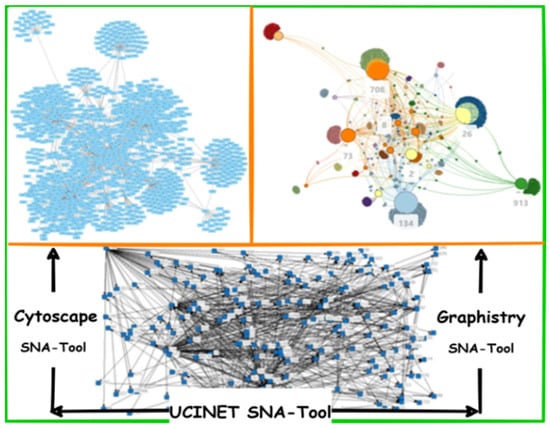
Figure 3.
The constructed directed graph using different SNA tools.
A comparative analysis of three famous SNA software tools (i.e., Graphistry, Cytoscape, and the University of California at Irvine network (UCINET)) was conducted to choose the most suitable tool for this proposed work. According to our view and based on the evaluation process conducted in [4], Graphistry is the best relevant SNA software tool to adopt. Compared with the other tools, it was found to be the best in terms of visualization, scalability, and ease of use. Figure 3 shows the different representations of our directed graph using the three mentioned SNA software tools. As illustrated in Figure 3, we can easily identify bridges and popular users in Graphistry and Cytoscape while nothing can be identified using UCINET. Nodes in Graphistry are represented with large circle sizes with a large degree of centrality measures. The larger the degree of centrality of a node, the larger the circle size and vice versa. Moreover, Graphistry was easier for loading the data and building the directed graph.
- (2)
- Artificial Neural Network Ranking Process
In this step, the collected data about tweets’ reaction features (i.e., likes, counts, etc.) is combined with the centrality measures of their opinion holders obtained from the SNA process to help rank opinion holders based on their tweet’s influence as well as their topological influence in the social network. Opinion holders obtain scores from 1 to 100. When centrality measures are high or/and their tweets obtain high reactions, then opinion holders obtain a high score and are highly ranked. ANN is used for this step; Figure 4 shows the steps of the ANN scoring process. ANN adoption was due to the complexity of this behavioral data to be mathematically represented. Figure 5 shows, in practice, the correlation between a sample data of action-based records (X-axis) and the resultant users’ score (Y-axis) when plotted. It can be noticed that, for example, authors of low action-based tweets’ counts can highly score and vice versa. Thus, there is no certain guidance rule for scoring users based on their tweets’ action-based counts.
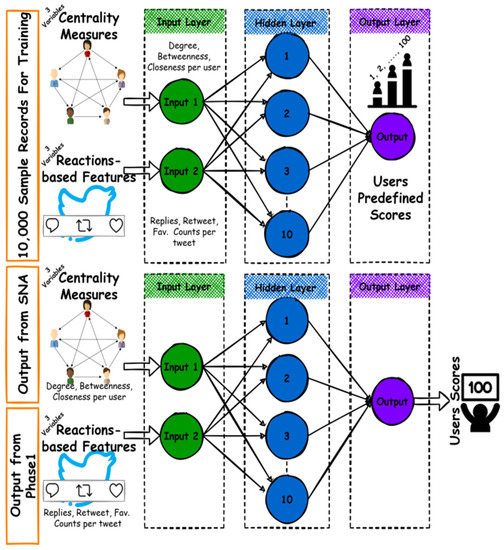
Figure 4.
The training and scoring processes of the constructed ANN.
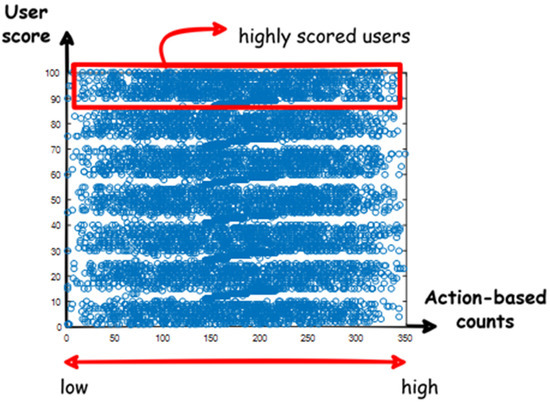
Figure 5.
Correlation between users’ scores and their tweets reactions.
A trial and error approach was followed and resulted in a constructed feed-forward ANN with 10 neurons in its hidden layer. In the training process, a sample of 100 to 10,000 records per input was applied to improve training performance and decrease scoring errors.
Figure 6 illustrates the impact of applying 100 and 10,000 training samples on the ANN process error, where error seemed to decrease as training samples increased. Another observation is the dependency on the out-of-degree measure rather than other centrality measures. The output of the constructed ANN is a user score of 100; a user with a score of 100 is a highly ranked user, while one with a score of 1 is a lowly ranked one. These output scores are normalized to represent users’ important weighting; high-scoring users are highly ranked with a higher importance weight than others in the same social network. Users’ importance weighting results in classifying opinion holders into 4 main classes or types as follows: Micro, Macro, Mega, and A-Listers Influencers [25,26,27,28]. Figure 7 summarizes how opinion holders are classified in this proposed work and their influence levels.

Figure 6.
(a) A training performance of 9.6461 with 100 Samples, (b) a training performance of 4.1030 with 10,000 Samples.
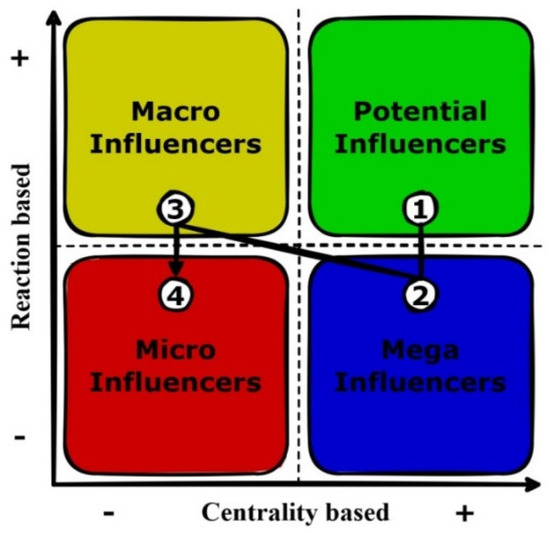
Figure 7.
Opinion holders’ classification based on their influence level.
- -
- Micro influencers: This category is of a low influence level that may include: personal users, secondary actors, retweeters, or silent followers. These users exhibit poor behavior in their social networks. Neither active nor sparing, they use their account when they like to and for their purposes (i.e., entertainment, news, and learning). Thus, Micro influencers can possess low reactions to their writings and low centrality measures as shown in Figure 7;
- -
- Macro influencers: Their influence level lies between low and moderate influence. It includes actors with important content, builders, or even trolls. They work on building and growing their relationships and increasing their social network engagement through creating interesting content or even inflammatory conversation. Thus, they can possess high reactions to their writings as shown in Figure 7. They can become mega influencers with time based on their ability to gain audience trust;
- -
- Mega Influencers: This category’s influence level can lie between moderate and high influence levels. It may include business users, brokers, and newscasters. They are followed by a large sector for being the source of information. Thus, they possess high centrality measures as shown in Figure 7. They record an active presence on social media, providing service, marketing, advertising, etc.;
- -
- A-list influencers or potential influencers: They own the highest influence level. They are extremely popular and have between thousands and millions of followers. They include: celebrities, the most recognizable people on earth that tend to act, sing, play football, etc.; or professionals who have grown a strong brand for themselves for sharing useful information about topics of professional interest, fostering interaction, and being followed by many. Thus, they possess both high reactions and centrality measures as shown in Figure 7.
4.3. Opinion Mining Process
This phase deals with the opinion texts of the data collected in the first phase. It includes two main steps: text preprocessing and opinion classification. A lexicon technique (i.e., TextBlob) is to be applied to the collected tweets. TextBlob is a natural language processing (NLP) Python library that returns two values for SA: polarity and subjectivity, with a standard range of , where negative values refer to negative statements and positive ones to positive statements. In our work, TextBlob was utilized for the two mentioned steps of this phase. The reason for choosing a lexicon classifier, TextBlob in particular, is owing to the previous intention to perform a hybrid classification of tweets by combining lexicon, in this case, TextBlob, with ML, which is NL in the final phase. TextBlob was chosen for its proven ability to deal with informal texts from preprocessing to polarity classification [8]. The preprocessing step was performed using TextBlob and includes:
- -
- The removal of the uniform resource locators (URLs), @username, stop words, etc.;
- -
- The substitution of slang, emoticons, etc. Example of one tweet before preprocessing: RT @FIFAWorldCup: #FRA #FRA #FRA “This is amazing, it’s pinnacle: France are on top of the world!” @FIFIAWorldCupFRA heard from #WorldCu. After preprocessing, this tweet becomes: amazing pinnacle France top world heard. Afterward, polarity classification of the preprocessed tweet is performed using TextBlob. The polarity classification of the above-mentioned example is sentiment (polarity = 0.55, subjectivity = 0.7).
4.4. Neutrosophic-Based OM Classification
It is the final and most important phase in this proposed model for two reasons: it integrates the new elements of opinion into the traditional opinion elements. In addition, NL can deal with different classification uncertainties that do exist in the case of the OSNs:
- -
- Opinion dynamicity: Where opinions about the same entity can vary from one person to the other. NL can deal with opinion dynamicity; its properties accept this difference and can handle it to achieve a consensus opinion about the entity [9,21]. To achieve consensus in neutrosophy, opinions with different observations ( polarity scores) should have only one score of triple representation . In this case, we implement a weighted average formula for each component inspired by the work performed in [21] that is defined as:where ,, and are the overall true, indeterminate, and falsity scores of the opinion text , respectively. and represent the polarity scores assigned to the same opinion sentence by the observers of both the highest and the lowest influence level , respectively. For example, is the true component of the opinion sentence assigned by the first highest influence observer.
- -
- Opinion indeterminacy: This is when humans cannot be certain. It is the case of neither being true nor false. In the field of OM, this can appear in classifying an opinion as neutral for just being unable to determine its real intended polarity, or for having positive and negative words of zero resultant sum, and thus, considered neutral. This type of polarity classification is not considered until NL appears; where each opinion can have a degree of truth, indeterminacy, or falsity. NL can deal with the failure in determining the polarity of text by considering it of a high indeterminate degree, which is more accurate than considering it neutral or with any other wrong polarity class that badly affects the accuracy of results.
- -
- Classification ambiguity: It is a part of indeterminacy where the classified output lies in the common area between two classes. NL can effectively deal with this case by setting a confident value for the truth component (). Figure 8 shows an example of a graphically represented neutrosophic set and how a confident value can be set on it. Using this value, one can determine the significance of components for a given opinion’s score. If is greater than the confidence value (i.e., 0.5 based on [9]), then the corresponding components can be considered insignificant [9]. All the above-mentioned purposes can be achieved using the following steps:
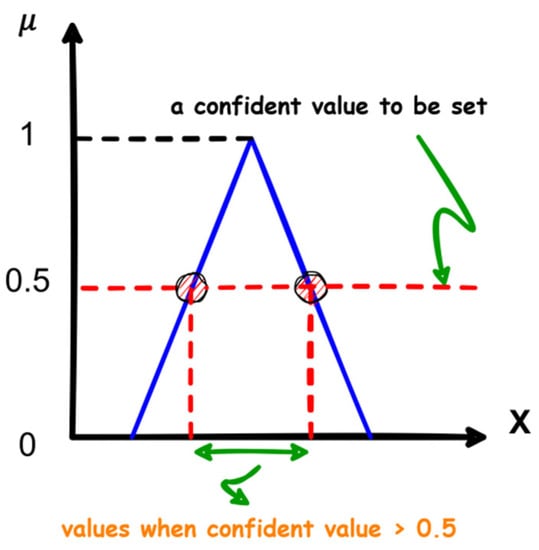 Figure 8. A confident value set on a neutrosophic set.
Figure 8. A confident value set on a neutrosophic set.
- (1)
- Neutrosophication
In this step, the crisp inputs are converted to neutrosophic-based inputs using three membership functions that represent: truth, indeterminate, and failure membership, per input [20]:
- -
- Input 1: Represents user’s influence (UI), the newly added opinion element. This input ranged from 0 to 1 with three linguistic variables, low, moderate, and high influence (LI, MI, and HI), to build the truth, indeterminate, and falsity membership functions. The membership functions are trapezoidal inspired by [10].
- -
- Input 2: Represents the opinion orientation, the traditional opinion element, namely polarity score . This input’s range is with seven linguistic variables: strong negative (SN), negative (NEG), weak negative (WN), neutral (N), weak positive (WP), positive (P), and strong positive (SP) with three triangular-shaped membership functions, also inspired by [10].
- (2)
- Inference Engine/or Rule Evaluation
In this step, the neutrosophic inputs are converted into neutrosophic outputs using IF-THEN rules. The rules were designed to cover all the truth, indeterminate, and falsity cases for the inputs and their corresponding outputs. The above-mentioned inputs are the antecedents joined by the minimum operator “AND”. The designed rules are based on the designed rules in [9,10] and are found to be 45 rules. A sample of the designed NL rules for the truth component is listed in Table 1. MI-t, for example means true moderate influence.

Table 1.
Sample of the designed NL rules.
- (3)
- Deneutrosophication
In this final NL step, the output of the inference engine (i.e., the neutrosophic outputs) is converted into a crisp output using the corresponding three membership functions and a suitable modulation technique. In this work, the center of gravity (COG) was chosen to determine the defuzzified output () from the accumulated output of the rules () which is defined as:
4.5. Desired Opinion Polarity Class
In this step, a final polarity class is determined, inspired by the polarity classes applied in [10]. This work applied seven polarity classes, known as: strong positive, positive, weak positive, neutral/or indeterminate, weak negative, negative, and strong negative. Table 2 shows the seven polarity classes and their corresponding ranges. We added a new polarity class to neutral, namely “indeterminate”. It is when the text is neither neutral nor any of the existed classes. This is a bonus from using NL; we can say the class of a certain text is undecided. The obtained final class of polarity and the indeterminate class are determined by Equation (8) as shown below:

Table 2.
The seven polarity levels [10].
5. Experimental Results
To effectively validate the proposed model, a desktop program was developed using Python, for implementing TextBlob, and the matrix laboratory (MATLAB) libraries for implementing ANN and NL. Toolboxes for ANN and fuzzy logic were used to build the proposed ANN and NL classifiers. The fuzzy toolbox was used due to the unavailability of a toolbox for NL until this time and the proven possibility of implementing NL using the fuzzy toolbox as mentioned in [9]. The dataset already collected and filtered in [10] was used as a consequence of the absence of a benchmark dataset that combines the opinion text, its writer’s following/followers list, and its tweet reaction counts. Table 3 documents the polarity classification of 1080 collected tweets using TextBlob.

Table 3.
Polarity distributions of the dataset using TextBlob.
Regarding the contribution phase of adding a new element into the basic opinion elements, the constructed ANN operated with efficient performance and attempted to classify the opinion holders of the dataset into the four mentioned types. Table 4 reports the resultant ANN classification errors of each of the opinion holder types. It was obvious that the constructed ANN trained more on the low-level influencers than on the high-level influencers. This can be due to the abundant presence of the low influencers in training and real-life compared with the presence of the high influencers. Figure 9 emphasizes this observation and shows the results of the ANN classification of the opinion holders in the used dataset. The lower influencers have the highest percent, and this can be a caution for the decisionmakers to not rely on the traditional OM results while dealing with OSNs without classifying their opinion holders, as there would be spammers and people of low impact whose opinions are not that worthwhile.

Table 4.
Average errors in the ANN classification.
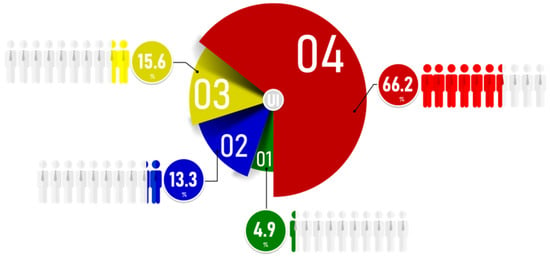
Figure 9.
Opinion holders’ classification in the dataset.
According to our proposed model, opinion holders on OSNs share opinions of the same polarity as others, but they should vary in their obtained OM polarity scores due to their influence on the audience. Figure 10 shows the polarity change from a regular OM process with its basic opinion elements using TextBlob and after integrating the new element of opinion (i.e., user’s weight) into them using NL. It is obvious the difference in the resultant polarity classes when considering users’ importance and influence on others. Due to the large percentage of low influencers in the considered dataset, we can notice the increase in the percentage of the neutral class for most texts due to the low effect of their users.
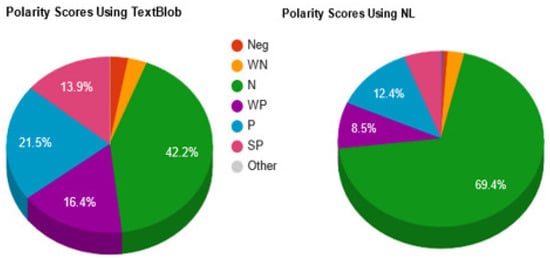
Figure 10.
Polarity classes differences before and after considering user’s weight.
In the OM process, we usually use any tool/technique to obtain a polarity score for a given text. Each tool may provide the same text a different polarity score due to many factors such as the tool’s accuracy. In contrast, in our model, opinion holders can share the same opinion text, but due to our consideration of a user’s weight, these same opinion texts should have different polarity scores based on their sharer’s importance in the social network. To deal with such a case is similar to dealing with applying different OM techniques to the same text. In this case, the NL allows such a feature that it allows different observations for the same text and can obtain a polarity score for the problem text. Table 5 shows an example sample of retweeted texts through different influence level users. They were provided different scores and we reported how the NL dealt with such cases.

Table 5.
Samples of opinion dynamicity in the dataset.
For solving the problem of indeterminacy class, our proposed model highlighted the existence of undecided polarity and tried to identify it in the used dataset. Figure 11 shows the effect of such detection on the neutral polarity, where it is obvious that the neutral percentage in the dataset decreases from 69 to 51% due to the efficient identification of the undecided polarities in texts. Compared with cases #1 and #2, the neutral class normally increases while applying our proposed model due to the existence of low influencers whose tweets can be perceived as neutral. However, after considering the three components of NL, the neutral class increased (i.e., case #3) due to the existence of undecided polarities that were automatically considered neutral. By excluding these undecided cases, the final neutral class becomes an accurate representation of that class in the dataset.
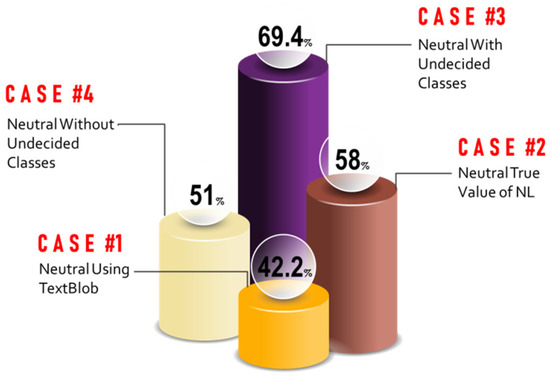
Figure 11.
Neutral class change cases.
According to [8], small changes can shift feelings from being SP to P. Some opinions can still be SP ignoring any changes, while others may have different polarities at the same time. Undecided cases can happen and must be efficiently identified without approximation or dominant choice. Deep in the undecided cases identified in the dataset, Table 6 shows some undecided cases. Then Equation (10) was applied to solve such existence of undecided polarities. If undecided polarities are undecided after applying (10), then it was classified as indeterminate. Figure 12 presents the final polarity scores that were provided using the proposed model after detecting and dealing with opinions’ indeterminacy and dynamicity.

Table 6.
Sample cases of undecided polarities in the dataset.
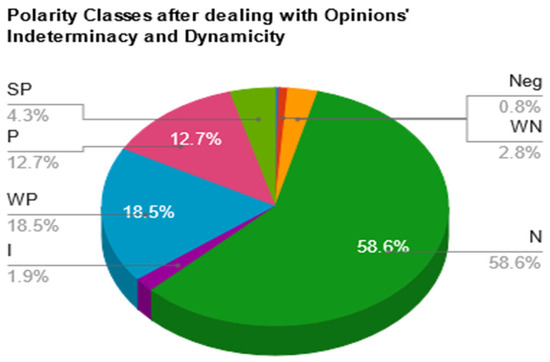
Figure 12.
The final polarity classification using the proposed model.
Table 7 documents the difference between the basic element representation of opinions and the new proposed representation that we believed in its significance when applying OM to OSNs. We wanted to show how this proposed model can represent public opinion with its newly added element. Using this new representation, we can obtain a polarity score that is certain and close to what is perceived by the audience of the opinion holder, where the audience can rate this opinion in the same way we proposed.

Table 7.
Opinions representation between the classic elements and the new proposed elements.
6. Conclusions, Limitations, and Future Work
In this study, we proposed a neutrosophic-based SA process suitable for the uncertain nature of OSNs. In the proposed model, a new element was integrated with the classical opinion elements using NL. The new element is the user’s weight, which depends on measuring the influence of users using the SNA centrality measure and recorded reactions to their expressed opinions, then classifying them into four main influencer types using ANN. A comparative analysis of different SNA tools was conducted and ended in choosing Graphistry for the mission. Different polarity scores than the regularly applied techniques, TextBlob in our case, were generated due to the perspectivism factor of users. This resulted in different scores for the same text when shared by users of different influence levels. NL was implemented for the integration purpose of all opinion elements, to provide hybrid classification, and for its ability to handle the resulted opinion dynamicity by considering perspectivism, and the classification indeterminacy. The proposed model succeeded in representing the perspectivism in an effective numerical way by classifying users of the dataset into their influence types using ANN with promising error performance. Moreover, the proposed model opportunely processed perspectivism and SA in parallel, as planned, and integrated both processes using NL. As the first of its type encouraging application, NL effectively achieved the goal of solving the problem of opinion dynamicity and identifying undecided polarities by emulating humans that in turn reflected on the process of OM and its dependable results. On top of that, the proposed model appropriately emphasized readapting OM while applying OSNs to texts for high-quality information suitable for accurate decision making. The limited training sets for the ANN and the adoption of more state-of-art- approaches for ranking users (e.g., Deep Learning) are the limitation of this study. Optimizing error performance of influencers’ classification and including non-textual posts are our future work aims.
Author Contributions
Data curation, R.E.; Formal analysis, S.M.D.; Investigation, A.A.I.; Methodology, S.M.D.; Resources, R.E.; Software, R.E. and A.A.I.; Validation, S.M.D.; Writing—original draft, R.E. and A.A.I.; Writing—review & editing, S.M.D. All authors have read and agreed to the published version of the manuscript.
Funding
This research received no external funding.
Institutional Review Board Statement
The study did not require ethical approval.
Informed Consent Statement
Not applicable.
Data Availability Statement
Not applicable.
Conflicts of Interest
The authors declare no conflict of interest.
References
- Klimiuk, K.; Czoska, A.; Biernacka, K.; Balwicki, Ł. Vaccine misinformation on social media–topic based content and sentiment analysis of polish vaccine-deniers’ comments on facebook. Hum. Vaccines Immunother. 2021, 17, 2026–2035. [Google Scholar] [CrossRef] [PubMed]
- Subriadi, A.P.; Baturohmah, H. Social media in marketing of ride-hailing: A systematic literature review. Procedia Comput. Sci. 2022, 197, 102–109. [Google Scholar] [CrossRef]
- Tsapatsoulis, N.; Djouvas, C. Opinion mining from social media short texts: Does collective intelligence beat deep learning? Front. Robot. AI 2019, 5, 138. [Google Scholar] [CrossRef] [PubMed] [Green Version]
- Camacho, D.; Panizo-LLedot, Á.; Bello-Orgaz, G.; Gonzalez-Pardo, A.; Cambria, E. The four dimensions of social network analysis: An overview of research methods, applications, and software tools. Inf. Fusion 2020, 63, 88–120. [Google Scholar] [CrossRef]
- Choudhary, A.; Arora, A. Linguistic feature based learning model for fake news detection and classification. Expert Syst. Appl. 2020, 169, 114171. [Google Scholar] [CrossRef]
- Serrano-Guerrero, J.; Romero, F.P.; Olivas, J.A. Fuzzy logic applied to opinion mining: A review. Knowl. Based Syst. 2021, 222, 107018. [Google Scholar] [CrossRef]
- Oueslati, W.; Arrami, S.; Dhouioui, Z.; Massaabi, M. Opinion leaders’ detection in dynamic social networks. Concurr. Comput. Pract. Exp. 2020, 33, e5692. [Google Scholar] [CrossRef]
- Kandasamya, I.; Vasanthaa, W.; Obbinenib, J.; Smarandache, F. Sentiment analysis of tweets using refined neutrosophic sets. Comput. Ind. 2020, 115, 103180–103190. [Google Scholar] [CrossRef]
- Ansaria, A.; Biswasb, R.; Aggarwal, S. Neutrosophic classifier: An extension of fuzzy classifier. Appl. Soft Comput. 2012, 13, 563–573. [Google Scholar] [CrossRef] [Green Version]
- Madbouly, M.; Darwish, S.; Essameldin, R. A modified fuzzy sentiment analysis approach based on user ranking suitable for online social networks. IET Softw. 2020, 14, 300–307. [Google Scholar] [CrossRef]
- Lanel, G.H.J.; Jayawardena, H.S.S.P. A study on graph theory properties of on-line social networks. Int. J. Sci. Res. Publ. 2020, 10, 267–274. [Google Scholar] [CrossRef]
- Jianqiang, Z.; Xiaolin, G.; Feng, T. A new method of identifying influential users in the micro- blog networks. IEEE Access 2017, 5, 3008–3015. [Google Scholar] [CrossRef]
- Jin, Z.; Zhao, X.; Liu, Y. Heterogeneous graph network embedding for sentiment analysis on social media. Cogn. Comput. 2021, 13, 81–95. [Google Scholar] [CrossRef]
- Chauhan, P.; Sharma, N.; Sikka, G. The emergence of social media data and sentiment analysis in election prediction. J. Ambient Intell. Humaniz. Comput. 2020, 12, 2601–2627. [Google Scholar] [CrossRef]
- Muzaffar, A.; Nafi, M.; Sohail, S. Neutrosophy logic and its classification: An overview. Neutrosophic Sets Syst. 2020, 35, 239–251. [Google Scholar]
- Christianto, V.; Smarandache, F. A review of seven applications of neutrosophic logic: In cultural psychology, economics theorizing, conflict resolution, philosophy of science, etc. Multidiscip. Sci. J. 2019, 2, 128–137. [Google Scholar] [CrossRef] [Green Version]
- Radwan, N.; Senousy, M.B.; Riad, A.E.D.M. Neutrosophic logic approach for evaluating learning management systems. Neutrosophic Sets Syst. 2016, 11, 3–7. [Google Scholar]
- Basha, S.H.; Abdalla, A.S.; Hassanien, A.E. NRCS: Neutrosophic rule-based classification system. In Proceedings of SAI Intelligent Systems Conference, London, UK, 21–22 September 2016; Springer: Berlin/Heidelberg, Germany, 2016; pp. 627–639. [Google Scholar]
- Bhutani, K.; Aggarwal, S. A novel approach for data classification using neutrosophic entropy. Adv. Intell. Syst. Comput. 2018, 732, 305–317. [Google Scholar]
- Smarandache, F.; Teodorescu, M.; Gîfu, D. Neutrosophy, a Sentiment Analysis Model. In Proceedings of the RUMOUR 2017, 3rd Workshop on Social Media and the Web of Linked Data, Toronto, ON, Canada, 22 June 2017; pp. 38–41. [Google Scholar]
- Smarandache, F.; Colhon, M.; Vlăduţescu, Ş.; Negrea, X. Word-level neutrosophic sentiment similarity. Appl. Soft Comput. J. 2019, 80, 167–176. [Google Scholar] [CrossRef]
- Benedetto, F.; Tedeschi, A. Big data sentiment analysis for brand monitoring in social media streams by cloud computing. In Sentiment Analysis and Ontology Engineering Studies in Computational Intelligence; Springer: Berlin/Heidelberg, Germany, 2016; pp. 341–377. [Google Scholar]
- Ficara, A.; Fiumara, G.; De Meo, P.; Liotta, A. Correlation analysis of node and edge centrality measures in artificial complex networks. In Proceedings of the Sixth International Congress on Information and Communication Technology, London, UK, 25–26 February 2021; Springer: Singapore, 2022; pp. 901–908. [Google Scholar]
- Zhuang, Y.-B.; Li, Z.-H.; Zhuang, Y.-J. Identification of influencers in online social networks: Measuring influence considering multidimensional factors exploration. Heliyon 2021, 7, e06472. [Google Scholar] [CrossRef]
- Quan, T.-T.; Mai, D.-T.; Tran, T.-D. CID: Categorical influencer detection on microtext-based social media. Online Inf. Rev. 2020, 44, 1027–1055. [Google Scholar] [CrossRef]
- Litterio, A.M.; Nantes, E.A.; Larrosa, J.M.; Gómez, L.J. Marketing and social networks: A criterion for detecting opinion leaders. Eur. J. Manag. Bus. Econ. 2017, 26, 347–366. [Google Scholar] [CrossRef] [Green Version]
- Ruiz-Gomez, A. Digital fame and fortune in the age of social media: A classification of social media influencers. Adres. ESIC Int. J. Commun. Res. 2019, 19, 8–29. [Google Scholar] [CrossRef] [Green Version]
- Uddin, M.; Imran, M.; Sajjad, H. Understanding types of users on twitter. arXiv 2014, arXiv:1406.1335. [Google Scholar]
Publisher’s Note: MDPI stays neutral with regard to jurisdictional claims in published maps and institutional affiliations. |
© 2022 by the authors. Licensee MDPI, Basel, Switzerland. This article is an open access article distributed under the terms and conditions of the Creative Commons Attribution (CC BY) license (https://creativecommons.org/licenses/by/4.0/).